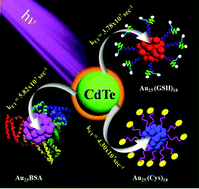A study into the role of surface capping on energy transfer in metal cluster–semiconductor nanocomposites†
Abstract
Metal cluster–semiconductor nanocomposite materials remain a frontier area of research for the development of optoelectronic, photovoltaic and light harvesting devices because metal nanoclusters and semiconductor QDs are promising candidates for photon harvesting. Here, we have designed well defined metal cluster–semiconductor nanostructures using different surface capped negatively charged Au25 nanoclusters (Au NCs) and positively charged cysteamine capped CdTe quantum dots using electrostatic interactions. The main focus of this article is to address the impact of surface capping agents on the photophysical properties of Au cluster–CdTe QD hybrid nanocomposites. Steady state and time resolved spectroscopic studies reveal that photoluminescence quenching, radiative and nonradiative rate, and energy transfer between Au nanoclusters and CdTe QDs have been influenced by the nature of the capping agent. We have calculated the energy transfer related parameters such as the overlap integral, distance between donor and acceptor, Förster distance, efficiency of energy transfer and rate of energy transfer from CdTe QDs to three different Au NCs. Photoluminescence quenching varies from 73% to 43% when changing the capping agents from bovine serum albumin (BSA) to glutathione (GSH). The efficiency of the energy transfer from CdTe QDs to BSA-capped Au NCs is found to be 83%, for Cys-capped Au NCs it was 46% and for GSH-capped Au NCs it was 35%. The efficiency depends on the number of Au clusters attached per QD. This reveals that the nature of capping ligands plays a crucial role in the energy transfer phenomena from CdTe QDs to Au NCs. Interesting findings reveal that the efficient energy transfer in metal cluster–semiconductor nanocomposites may open up new possibilities in designing artificial light harvesting systems for future applications.


 Please wait while we load your content...
Please wait while we load your content...